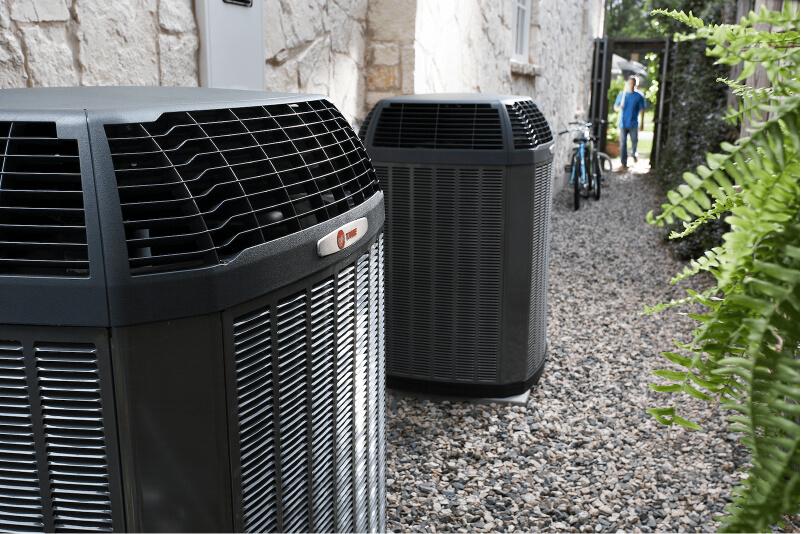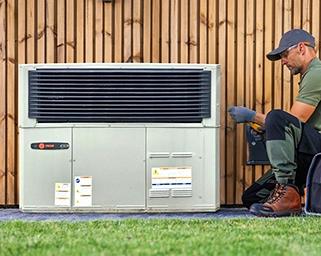HVAC Systems: Basics to Know Before You Buy
Learn the basics of home heating and cooling like costs, key terms, products, basic maintenance schedules and more.
Confused about home heating and cooling? It turns out you’re not alone. According to Consumer Reports, it turns out that 20 percent of Americans reported needing to repair or replace their HVAC systems in the last year – but the majority felt overwhelmed with the process.
If you don’t know where to begin, don’t worry. Before you start a project or make a major HVAC purchase, we can help you get up to speed on what you need to know to make the best choice for you and your home.
HVAC Meaning: What is HVAC?
HVAC stands for heating, ventilation and air conditioning systems. This system is responsible for heating and cooling your home and includes products like furnaces, air conditioners, heat pumps as well as ductwork, thermostats and other home comfort controls.
While the world of HVAC might seem complicated, it doesn’t have to be confusing for homeowners. Once you learn a little more about how the systems work, the HVAC meaning and all the technical components will make more sense, and you can learn even more by watching this video that discusses HVAC and working with an expert dealer.
What is an HVAC system?
There are many moving parts that work to not only warm you in winter and cool you in summer, but also filter and purify your air to help protect you and your family from allergens, pollutants, and harmful chemicals. Breaking down the different parts of an HVAC system, or the heating and cooling products within homes, can help you to understand each system’s role in bringing you comfort throughout the year. Watch this video on how HVAC systems work to learn more details on heating and cooling systems and how you can achieve optimal comfort in your home and get more information on each system below.
Furnace
Most people understand that a furnace heats a home, but don’t understand all the intricacies involved in the system. All furnaces consist of four main components: 1) burners that deliver and burn fuel, 2) heat exchangers, 3) a blower and 4) a flue that acts as an exhaust for gaseous by-products. A furnace generates heat by burning fuel and distributes the generated heat throughout the house.
Air conditioner
An air conditioner draws heat energy out of the house and transfers it to the outside air. The most common setup for residential homes is a split system, which includes an inside-the-home evaporative heat exchanger and an outside condensing unit heat exchanger.
Heat pump
A heat pump is an energy-efficient option to consider if you live in a mild climate zone. It uses the outside air to heat a home in winter and cool it in summer. Heat pumps are often misunderstood by homeowners, especially as a cooling system given their name contains the word “heat.” In the simplest sense, a heat pump “pumps heat” from one place to another, moving heat out of your home when you want it cooler, and pumping heat into your home when you want it warmer.
Air handler
An air handler most commonly works with a heat pump to circulate air throughout your home. If you’re searching for a traditional air conditioner or furnace, you won’t need an air handler as those systems have the internal parts needed to circulate air.
Ductless systems
A ductless HVAC system or mini split is a heating and cooling system designed to deliver warm or cool air to a single room or several without the need for connective ductwork. Mini split systems are a great option for room additions, sunrooms, garages or areas of the home that need to be warmer or cooler. Ductless systems are a great option to heat or cool a single room in your home without the hassle of adding ductwork.
Thermostat
A thermostat, located inside your home, is a regulating device that allows you to control your indoor temperature. Thermostats are generally split into two classifications: traditional or connected controls. Basically connected, or smart thermostat controls, can integrate with other smart home systems and learn over time how to most efficiently heat and cool your home. Traditional thermostats are simpler — but several offer programmable features as well.
What factors affect the cost of a new HVAC system?
There are many ways to save on a new Trane HVAC system. Talk to your local dealer about how to save on local rebates, tax credits, and special, limited-time offers. Here are some of the main factors that affect the cost of a new heating and cooling system.
Location
Region and climate matter when finding the right system for your home and saving energy. The heating and cooling needs will differ in the hot and humid south and cold north. Also, installation costs can vary by as much as 20% depending on where you live.
Home size and construction
A large home will need a larger unit or even multiple systems to properly maintain a comfortable temperature — which of course will cost more than a smaller home. In addition, proper seals on windows and doors and the quality of your home’s insulation will affect your monthly heating and cooling costs.
Ductwork
Ductwork plays a crucial role in determining how comfortable your home is from room to room. When properly designed and installed, a duct system can maximize comfort and minimize energy use. If you’re installing a new HVAC system in a newly constructed home or replacing ductwork in a current home, adding ductwork will add as much as $2,000 - $3,000 to the total cost of your HVAC system.
Project difficulty
If your new system is planned for a hard-to-reach space or if you live in a historic home that requires retrofitting, you’ll see your HVAC installation price increase. Only with an onsite evaluation will these kinds of costs be discovered.
Indoor air quality and connected smart thermostats
Along with your traditional heating and cooling system, you have options to enhance the overall indoor air quality of your home with a Trane CleanEffects™ air cleaner or add climate zones with a ComfortLink™ II Zoning System or take advantage of the latest smart home, connected thermostat controls.
Heating and cooling terms to know
HVAC is very technical and it can be hard to make sense of all the acronyms, terms, and abbreviations. Here are a few top terms to help demystify the products to help you understand heating and cooling technology better – so that you can choose the HVAC system that is right for you.
- AFUE–Measures a furnace’s efficiency in converting heat to energy. A higher percentage means higher efficiency and lower energy costs.
- SEER2–Measures air conditioner or heat pump cooling efficiency. A higher number means greater efficiency and lower energy costs.
- HSPF2–A ratio for the heating efficiency of heat pumps. An HSPF of 7.8 HSPF2 or more is considered high efficiency.
- Split system–A split system has two parts: an outdoor unit and an indoor unit. Split systems are the most common HVAC systems in modern homes.
- Packaged system–Packaged systems are all-in-one solutions, with most of the components for heating and/or cooling housed in a single cabinet.
- Heating stages –Refers to the number of settings a furnace or heat pump has. Variable or multi-stage systems offer more precise temperature control and run more efficiently than single-stage systems.
- Cooling stages –Refers to the number of settings an air conditioner or heat pump has. Variable or multi-stage systems offer more precise temperature control and run more efficiently than single-stage air conditioners.
- ENERGY STAR®–The ENERGY STAR designation is designed to help consumers identify energy-efficient products.
- Hybrid system–A hybrid dual fuel system is an electric heat pump combined with a gas furnace.
Visit our HVAC glossary for more in-depth HVAC term information.
Seasonal HVAC maintenance schedule: What to expect
Whether your HVAC system is new and still under warranty or over 10 years old; routine maintenance service can get you ready for the upcoming season, lower your energy bills, extend the life of your system, and catch problems before they become costly repairs.
Scheduled HVAC maintenance includes items such as the following:
- Filter replacement
- Cleaning coils and condensers
- Replacing worn parts
- Clearing clogs or drain problems
- Checking for leaks
- Changing batteries, as needed
- Inspecting ducts for dust, mold, and debris
- Checking electrical system connections
- Inspecting blowers for airflow
- Inspecting heating elements or the heat exchanger
- Checking gas pressure
- Lubricating moving parts, such as bearings and motors
- Checking that assembly is in order
- Ensuring all parts are in good working order
It is easiest to remember to schedule maintenance for each system if you follow this standard:
Heating system (furnace or heat pump)
Schedule an appointment in late summer or early fall, before the heating season.
Cooling system (air conditioner or heat pump)
Schedule an appointment in late winter or early spring, before the cooling season.
How do you know if you should repair or replace your HVAC system?
If your home’s heating and cooling systems are no longer keeping you comfortable, it may be time to decide whether to repair or replace your HVAC system. There are some warning signs that it may be time to replace your HVAC – or if your HVAC system is no longer under warranty and the repair costs are getting too high.
Replace your system when:
- It needs frequent repairs.
- It’s suffering from poor performance.
- Your energy costs rise.
Replace your air conditioner if:
- It’s over 10 years old.
- Is rated 10 SEER or less.
Replace your furnace if:
- It’s over 15 years old.
- Is rated 80% AFUE or less.
Replace your heat pump if:
- It’s over 10 years old.
- Is rated 10 SEER or less | 8 HSPF or less.
Financial Tip: Follow the $5,000 Rule
Take the age of the equipment and multiply that by the estimated repair cost. If the number is more than $5,000, then you should consider replacing your unit.
One last tip: Talk to a dealer
Now that you know the basics, talk to your local Trane dealer for a detailed evaluation and recommendation for what heating and cooling solution is right for you.
What are the advantages of talking with an HVAC dealer?
A dealer is your best and only resource to truly evaluate your home's HVAC needs. Plus they can work with you to recommend a custom solution that fits your home and budget. They can help you with the following:
- Custom Home Evaluations
- Emergency repairs and seasonal maintenance
- Indoor air quality evaluation
- Local rebates and special offers
Watch this video to learn what you should know about working with an HVAC dealer.
Did you know?
- Over half of the energy usage in your home goes towards heating and cooling.*
- You can save an average of up to $576 on energy costs each year by upgrading to a more energy efficient HVAC system.**
- If you upgrade to a qualified, energy efficient HVAC system, you may be eligible for tax credits and rebates.
- Your local dealer can offer special offers and local rebates.
1ConsumerReports.org. HVAC Buying Guide, March, 2022.
*Department of Energy, 2010.
** Based on Energy Star’s Savings Calculator for a 3-ton 21 SEER/10 HSPF heat pump and programmable thermostat versus the industry standard 13 SEER/7.7 HSPF 3-ton heat pump and standard thermostat in St. Louis, MO.




